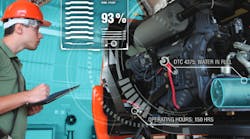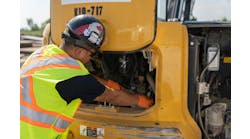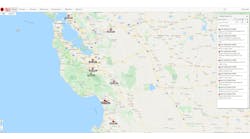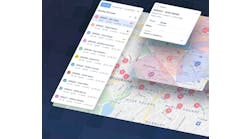Ara Eckel, director of product management, JLG’s connected solutions, talks about the company’s new fleet management platform, advancements in the applications of telematics, significant uptime improvements, and more.
RER: What have been the most important achievements in your telematics systems in the past year?
Eckel: In April, JLG offered a first look at its new ClearSky Smart Fleet, a next-generation Internet of Things platform for true, two-way fleet management and machine interactivity, at the Summit of the International Powered Access Federation in Berlin.
JLG ClearSky Smart Fleet is a global IoT solution developed by JLG specifically for JLG’s mobile elevating work platforms (MEWPs) and telehandlers, providing more actionable data about the equipment than any other telematics program. As an OEM-specific platform, it gives customers deep insights and information about what is going on with the equipment — not just where it’s at, but also how it’s being used. This depth of detail enables equipment owners and operators to make informed decisions about JLG products based on the relevant information available. It is a ground-up redesign, adding innovative elements to transform the way customers work. Key features include:
- Digitized daily processes for operational efficiencies
- Accurate and efficient machine location
- Additional equipment service capabilities
- Streamlined logistics with Automated Site Networks
- Actionable, on-demand machine and fleet insights
ClearSky Smart Fleet will be standard on most new machines produced later this year, and customers with existing JLG products can continue to use the legacy ClearSky program for their connected needs. Both platforms will be integrated into Online Express, JLG’s 24/7 e-Commerce site.
What have been the most important advancements in capabilities, enabling rental companies to improve efficiencies?
Eckel: ClearSky Smart Fleet reimagines what’s possible, paving the way to a new frontier for connectivity solutions in the industry. More than yet another singular piece of software, it’s built as a robust, constantly evolving IoT platform capable of delivering new functionality, new insights and new ways to run cost-effective operations.
As an example, the new ClearSky Smart Fleet system is designed to offer two-way communication, allowing for continued collection of data from the machine, while introducing the ability to push data to the machine. This enables the system to offer a wider range of functionality and deliver greater value.
Because IoT enables users to streamline access to important machine information quickly and effectively through digital channels, the most important advancements in telematics capabilities, enabling rental companies to improve efficiencies such as increased machine uptime and utilization.
For example, ClearSky Smart Fleet can show fleet managers where and how equipment is operating by providing high-level or finite details on several machine systems, including:
- Location to help with service planning and cuts on downtime for field techs
- Diagnostic trouble codes to address machine issues and get them back on rent quicker
- Machine hours to help with billing and knowing when to service the machine
- Battery status, including State of Charge and actively charging
- Machine utilization
- Automated Site Networks make geofencing a thing of the past
Access to this type of information allows users to manage machine usage more efficiently and effectively.
How will telematics advance in the next few years? What are customers expecting in the next level of telematics?
Eckel: We’re finally at a point in the industry with telematics where digital infrastructure and digital demand are coming together. As connected construction sites continue to evolve, telematics has provided a foundation and infrastructure for other technological advancements in safety and productivity. For example, historically telematics offered more data points from machines with combustion engines, but today, JLG’s ClearSky API also offers extensive information on electric equipment. This has opened opportunities for more customers to use our program.
Over the few years, we see telematics continuing to evolve to include even more machine information on electrified products, more finite details from the equipment’s integrated sensor suites, live/real-time video feed footage, in-the-moment servicing of machines, additional semi-autonomous functionality and so much more.
As the journey continues, I am looking forward to seeing how advancements in data, data analytics and data science will make telematics more and more valuable every day.
I’m sure you keep your eye on telematics development in other industries. What are some of the developments or trends in telematics that you’ve noticed in other industries that you admire, whether or not they are relevant to the rental industry?
Eckel: Telematics has become table stakes industrywide — today, everyone expects standard connectivity in their equipment. As a result, one trend that has re-emerged over the years from this is customers asking again for deeper machine insights. In the early days of telematics, customers wanted to access all of the data from the machine. Then, there was a period of time when customers said they were getting too much data and requested less. Today, the pendulum has swung back in the other direction, and users are again wanting more data from the machine, asking for even more than ever before.
To meet this demand, OEMs, including JLG, need to structure their telematics solutions in a way that is more efficient for customers to navigate, more meaningful in the way the system provides the data and more effective for them to use the data to proactively manage and maintain their fleets.
It seems there is a lot of discussion about artificial intelligence these days. Is AI relevant to the world of telematics in relation to the rental industry?
Eckel: Today’s technology is making it easier in general for the rental industry to access machine information and improve functionality. As digital connectivity continues to evolve, including discussions about artificial intelligence, we believe it’s time for the conversation to change — we should stop talking about telematics and talk about IoT. What’s the difference? The scope of telematics is primarily focused on the remote monitoring of an asset, which is actually quite narrow when compared to what IoT can bring to the table. As the internet connects devices and allows them to communicate to each other, the benefits of IoT in rental, including opportunities in the future to evaluate technologies like AI, can help equipment owners and operators be more competitive and solve common problems. It's really changing the whole market.
Anything you’d like to add?
Eckel: JLG was founded more than 50 years ago with a pioneering spirit that still drives our company’s thinking today — our customers are our priority, and we are committed not only to understanding their challenges but also to solving those challenges through customer-inspired innovations and the exploration of new technologies.
You can see how this strategy plays out in the development and evolution of all our digital product offerings, including telematics. Since it was first introduced, developments of new features and capabilities in JLG’s ClearSky Smart Fleet solution have been based on customer feedback, which has allowed us to continue to evolve our program to provide the most focused, meaningful data possible for JLG equipment.






